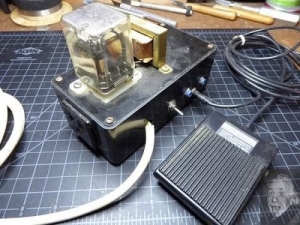The original motivation for this relay-controlled outlet was for those evil tools (like certain Dremels) that have the speed control mated to the on-off switch. Every time you turn the device off you lose your speed setting and have to fiddle to recover it when the tool is turned back on.
The obvious solution is to power the device through an external switch to supply the on/off function while the speed control remains at your chosen setting.
At the time I built this I had another application that involved controlling a powerful AC spot light from a distant location. I did not want to run the AC line feeding the light back to a local switch because of the power loss in a long power cord.
So the solution to both problems was to control the device (Dremel/light) via a local high current relay and switch the relay via a low current, low voltage switching arrangement.
In the photo you can see the relay on the top of the box and the outlet it feeds on the side of the box beneath it. The small filament transformer on the top powers a simple diode & capacitor setup inside the box to provide 8 VDC. This DC is fed to a series of connectors on the side of the box - two pin jacks, a phone f jack and a switch - all wired in parallel. When any of these connectors are shorted the DC closes a reed relay inside the box to provide power to the relay coil and close the contacts to feed the AC outlet.
Because only very low voltage is used in the control circuit, any light wire can be used to short the connectors. Two strand bell wire is cheap and easily available. The foot switch shown, reclaimed from an old Dictaphone, plugs into the phone jack for foot control. When sitting on the workbench to control something like a Dremel, the switch on the box is used and nothing need be plugged into the other connectors.
Over the years, this device has proved useful many times. The convenience of being able to string any old, cheap wire to safely control potentially dangerous power is really great.



 LinkBack URL
LinkBack URL About LinkBacks
About LinkBacks



 Reply With Quote
Reply With Quote



Bookmarks